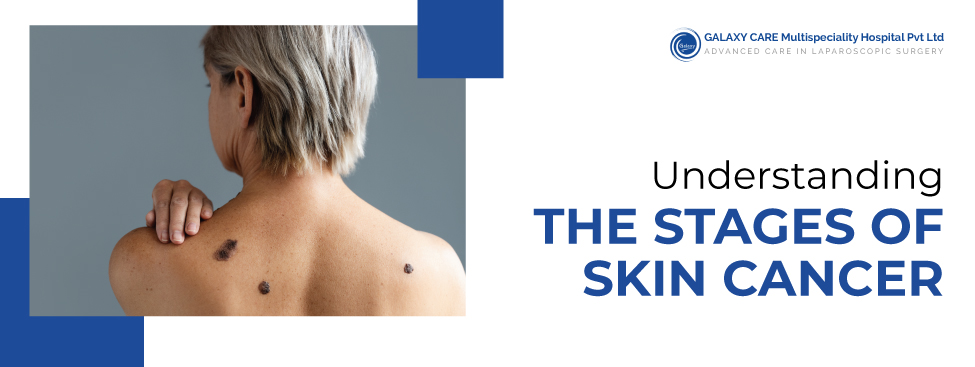
UNDERSTANDING THE STAGES OF SKIN CANCER
Skin cancer is a growing concern worldwide, affecting millions of individuals each year. As one of the most common forms of cancer, it is crucial to understand the various stages of skin cancer to recognize the signs, seek early diagnosis, and receive the appropriate treatment. Early detection is key, as it can drastically improve the chances of successful treatment and recovery. This comprehensive guide will delve into understanding the stages of skin cancer, providing you with the knowledge to take proactive steps towards your skin health. Let’s begin.
The Stages of Skin Cancer
Stage 0: Carcinoma in Situ
The first stage of skin cancer is known as carcinoma in situ, which is a non-invasive form of the disease. In this stage, the cancerous cells are confined to the outermost layer of the skin, known as the epidermis, and have not yet penetrated into the deeper layers. This stage is often considered the most treatable, as the cancer has not yet spread to surrounding tissues or organs.
Stage I: Early Invasive Skin Cancer
In stage I, the skin cancer has begun to invade the deeper layers of the skin, but it is still relatively small in size, typically less than 2 centimetres in diameter. The cancer may have also reached the underlying dermis layer, but it has not yet spread to nearby lymph nodes or other organs.
Stage II: Intermediate Invasive Skin Cancer
Stage II skin cancer is characterized by a larger tumor size, typically greater than 2 centimeters in diameter, and a deeper invasion into the skin layers. The cancer may have also begun to spread to nearby tissues, but it has not yet reached the lymph nodes or other organs.
Stage III: Advanced Invasive Skin Cancer
In stage III, the skin cancer has grown significantly and has begun to spread to nearby lymph nodes or other organs. The tumor may have also reached the deeper layers of the skin, including the subcutaneous fat. This stage is considered more advanced and may require a more comprehensive treatment plan.
Stage IV: Metastatic Skin Cancer
Stage IV is the most advanced and severe stage of skin cancer, where the cancer has spread to distant organs or lymph nodes. This stage is also known as metastatic skin cancer, and it can be particularly challenging to treat. The cancer may have also continued to grow and spread locally, making it more difficult to control.
Diagnosis and Treatment
Early detection is crucial in the successful treatment of skin cancer. The Best Oncologist in Pune at Galaxy Care Hospital recommend regular skin examinations and self-monitoring for any suspicious changes or growths.
If a suspicious lesion is identified, a cancer specialist will typically perform a biopsy to confirm the diagnosis and determine the stage of the skin cancer. This may involve taking a small sample of the affected tissue for further analysis.
Once the stage of the skin cancer has been determined, the treatment plan will be tailored accordingly. The treatment options may include:
- Stage 0 and Stage I: These early-stage skin cancers are often treated with surgical excision, where the cancerous tissue is removed. This may be followed by additional treatments, such as radiation therapy or topical chemotherapy, to ensure the complete removal of the cancer.
- Stage II and Stage III: For more advanced skin cancers, the treatment plan may involve a combination of surgical excision, radiation therapy, and systemic therapies, such as chemotherapy or targeted therapy. This approach aims to effectively remove the cancer and prevent its further spread.
- Stage IV: Metastatic skin cancer is typically treated with a combination of systemic therapies, such as chemotherapy, targeted therapy, and immunotherapy. The goal of treatment is to slow the progression of the cancer and improve the patient’s quality of life.
Preventing Skin Cancer
In addition to early detection and treatment, prevention is a crucial aspect of managing skin cancer. Here are some effective strategies to reduce your risk:
- Sun Protection: Limit your exposure to ultraviolet (UV) radiation from the sun or artificial sources, such as tanning beds. Wear protective clothing, use broad-spectrum sunscreen, and seek shade when possible.
- Regular Skin Checks: Perform regular self-examinations of your skin to identify any changes or suspicious growths. Additionally, schedule regular skin check-ups with a healthcare provider, such as a dermatologist.
- Avoid Tanning Beds: The use of tanning beds and other artificial UV sources has been linked to an increased risk of skin cancer. Avoid these devices and opt for safer, self-tanning products instead.
- Maintain a Healthy Lifestyle: A balanced diet, regular exercise, and stress management can contribute to overall skin health and reduce the risk of skin cancer.
Conclusion
Navigating the stages of skin cancer can be a daunting task, but with the right information and proactive approach, you can take control of your skin health. Understanding the different stages of skin cancer, recognising the signs and symptoms, and seeking early diagnosis and treatment can dramatically improve your chances of successful recovery.If you have any concerns about your skin health or suspect skin cancer, don’t hesitate to consult the Best Cancer Doctor in Pune at Galaxy Care Hospital. Our team of experienced and compassionate healthcare professionals is dedicated to providing comprehensive, patient-centred care to ensure the best possible outcomes for their patients. Feel free to get in touch and book your appointment soon.


